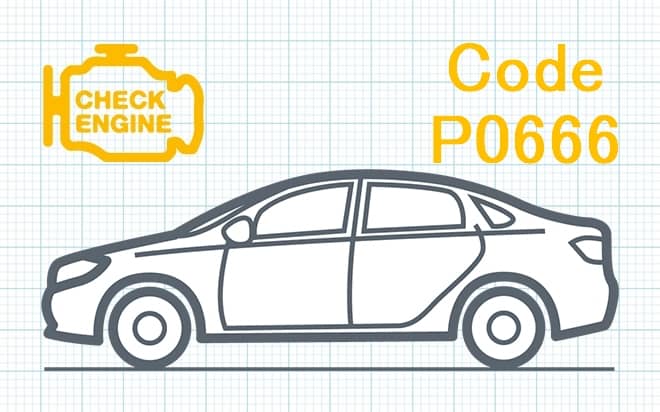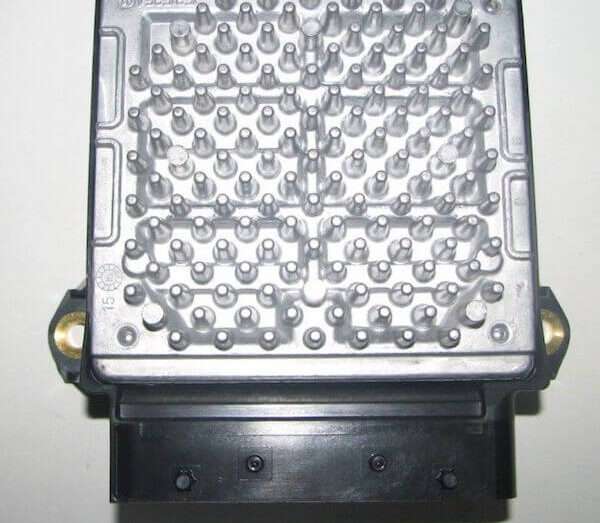
P0666 Transmission/Engine/Transaxle Control Module (PCM/ECM/TCM) Internal Temperature Sensor "A" Circuit Malfunction
Content
P0666 – OBD-II Trouble Code Technical Description
Trouble code P0666 indicates a problem with the powertrain control module (PCM), engine control module (ECM), or transmission control module (TCM) internal temperature sensor circuit.
What does the fault code mean P0666?
Trouble code P0666 indicates a problem with the powertrain control module (PCM), engine control module (ECM), or transmission control module (TCM) internal temperature sensor circuit in the vehicle. It should be noted that in most vehicles, the engine control module and transmission control module are combined into one component called the vehicle PCM. This code indicates that there may be a problem with the sensor that is responsible for measuring the internal temperature of the engine or transmission.

Possible reasons
Some of the possible causes of the P0666 trouble code are:
- Temperature sensor malfunction: The engine or transmission internal temperature sensor itself may be damaged or failed, resulting in incorrect signals or complete loss of communication.
- Damaged wiring or connectors: The wiring connecting the temperature sensor to the PCM, ECM, or TCM may be damaged, broken, or have poor connections. There may also be problems with the connectors into which the wires are inserted.
- PCM, ECM or TCM malfunction: The vehicle control module that receives signals from the temperature sensor may also be damaged or have internal problems that lead to P0666.
- Voltage problems: Irregular voltage in the electrical circuit caused by a short circuit, open or other electrical problems can also cause the P0666 code.
- Grounding problems: A ground fault in the vehicle's control system can cause the temperature sensor to malfunction and cause P0666.
These reasons may be related to both the sensor device and the electrical circuit that transmits signals from the sensor to the vehicle's control modules.
What are the symptoms of a fault code? P0666?
Symptoms for DTC P0666 can vary depending on specific conditions and vehicle characteristics, some of the potential symptoms are:
- Starting the engine in emergency mode: When a malfunction is detected, some vehicles may put the engine into limp mode, which may limit engine performance and speed.
- Loss of engine power: A malfunctioning temperature sensor may result in loss of engine power or rough running of the engine.
- Unstable engine performance: The engine may run erratically, such as shaking or unusual vibrations.
- Poor transmission performance: If the problem is with the transmission temperature sensor, it may cause unusual transmission behavior such as shifting jerks or delays.
- The Check Engine light comes on: Trouble code P0666 usually causes the Check Engine light to turn on on your vehicle's dashboard.
- Problems with fuel consumption: Incorrect operation of the temperature sensor may affect the fuel/air mixture, which may result in increased fuel consumption.
- Increased emissions of harmful substances: A malfunction related to engine temperature can lead to increased emissions of harmful substances such as nitrogen oxides or hydrocarbons.
Remember that symptoms may vary depending on the specific cause of the problem and the characteristics of the vehicle. If you suspect a P0666 code, it is recommended that you take it to a qualified auto mechanic for diagnosis and repair.
How to diagnose a fault code P0666?
The following steps are recommended to diagnose DTC P0666:
- Reading error codes: Use a diagnostic scanner to read error codes from the vehicle's control modules. Make sure the P0666 code is in the list of detected errors.
- Checking wiring and connectors: Inspect the wiring and connectors connecting the temperature sensor to the PCM, ECM or TCM. Check for damage, corrosion or breaks. Also check the connectors for bad contacts.
- Temperature sensor test: Check the temperature sensor itself for correct installation, damage or malfunction. Use a multimeter to test its resistance at different temperatures according to the manufacturer's specifications.
- Diagnostics of control modules: Check the operation of the PCM, ECM or TCM for malfunctions. Make sure that the modules receive the correct signals from the temperature sensor and process this data correctly.
- Electrical circuit check: Use the electrical circuit diagram to check the voltage and resistance at all connections and wires associated with the temperature sensor and control modules.
- Grounding check: Make sure that the ground in the electrical circuit is working properly, as an insufficient ground can cause the P0666 code.
- Additional tests: If necessary, perform additional tests, such as checking the engine or transmission operating temperature, to ensure that the temperature sensor is operating correctly.
- Updating the software: If all of the above steps fail to identify the problem, updating the PCM, ECM, or TCM software may help resolve the problem.
If you are unsure of your skills or do not have the necessary equipment, it is recommended that you contact a qualified auto mechanic or auto repair shop for diagnosis and repair.
Diagnostic errors
When diagnosing DTC P0666, the following errors may occur:
- Incomplete wiring check: If the wiring and connectors are not checked carefully enough, it may result in missing damage or breaks that could be causing the P0666 code.
- Incorrect interpretation of sensor data: Incorrect reading or misinterpretation of temperature sensor data may result in misdiagnosis and replacement of the functional component.
- Hardware problems: Using faulty or uncalibrated diagnostic equipment may result in incorrect results and erroneous conclusions.
- Incorrect software update: If the PCM, ECM or TCM software is not updated correctly or the wrong version of the software is used, it may cause additional problems or may not resolve the root cause of P0666.
- Ignoring other problems: Sometimes the P0666 code can be caused by other problems, such as problems with the ignition system, fuel system, or exhaust system. If these problems are ignored, it can lead to incorrect diagnosis and repairs.
- Wrong repair strategy: Selecting the wrong repair method or replacing components without thorough diagnosis may result in the problem not being corrected correctly and the P0666 code continuing to appear.
To minimize possible errors, it is recommended to use high-quality equipment, follow the manufacturer’s recommendations and carry out comprehensive diagnostics, checking all components and systems associated with the error.
How serious is the fault code? P0666?
Trouble code P0666 can be serious because it indicates a problem with the engine or transmission internal temperature sensor. These sensors play an important role in controlling engine and transmission performance, ensuring optimal performance and protection from overheating or other damage.
If the temperature sensor is not functioning correctly, it may result in poor engine operation, decreased performance, increased fuel consumption, and the risk of engine or transmission damage due to overheating or insufficient cooling.
Therefore, it is recommended that you take the P0666 code seriously and immediately diagnose and repair the problem. The problem causing this error code may require careful attention and prompt repair to prevent more serious damage or failure.
What repair will help eliminate the code? P0666?
Resolving the P0666 trouble code may require several steps depending on the specific cause of the error, some possible repair steps are:
- Replacing the temperature sensor: If the temperature sensor fails or fails, it must be replaced with a new one that meets the manufacturer's specifications.
- Repair or replacement of wiring and connectors: If damage or breaks are found in the wiring, it is necessary to repair or replace them. You should also check and clean the connectors from corrosion and make sure there is good contact.
- Checking and updating software: Sometimes the problem may be due to the PCM, ECM or TCM software not working properly. In this case, it may be necessary to update or reprogram the corresponding module.
- Grounding check: Make sure that the grounding in the electrical circuit is working properly, as insufficient grounding may cause the temperature sensor to not work properly.
- Additional tests and diagnosticsNote: In some cases, additional diagnostics may be required to identify other problems affecting the temperature sensor.
It is important to emphasize that for effective repairs, it is recommended to use original or high-quality spare parts, as well as contact qualified specialists or service centers, especially if you are not confident in your auto repair skills.
P0666 – Brand-specific information
Trouble code P0666 indicates a problem with the transmission/engine/transmission control module (PCM/ECM/TCM) internal temperature sensor “A” circuit. Below is a list of some car brands with their decodings:
- Ford:
- Code P0666 means: PCM/ECM/TCM Internal Temperature Sensor "A" Circuit Malfunction.
- Chevrolet:
- Code P0666 means: PCM/ECM/TCM Internal Temperature Sensor "A" Circuit Malfunction.
- Toyota:
- Code P0666 means: PCM/ECM/TCM Internal Temperature Sensor "A" Circuit Malfunction.
- Honda:
- Code P0666 means: PCM/ECM/TCM Internal Temperature Sensor "A" Circuit Malfunction.
- Volkswagen:
- Code P0666 means: PCM/ECM/TCM Internal Temperature Sensor "A" Circuit Malfunction.
- BMW:
- Code P0666 means: PCM/ECM/TCM Internal Temperature Sensor "A" Circuit Malfunction.
- Mercedes-Benz:
- Code P0666 means: PCM/ECM/TCM Internal Temperature Sensor "A" Circuit Malfunction.
- Audi:
- Code P0666 means: PCM/ECM/TCM Internal Temperature Sensor "A" Circuit Malfunction.
- Nissan:
- Code P0666 means: PCM/ECM/TCM Internal Temperature Sensor "A" Circuit Malfunction.
This is general information only and the actual meaning of the P0666 code may vary slightly depending on the model and year of your vehicle. It is important to perform more detailed diagnostic maintenance to determine the specific cause of the problem.
